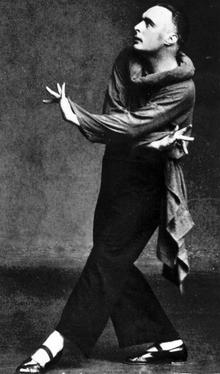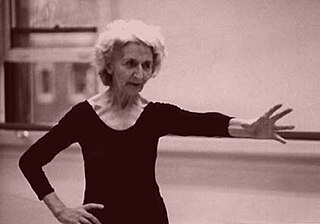In linguistics and semiotics, a notation is a system of graphics or symbols, characters and abbreviated expressions, used in artistic and scientific disciplines to represent technical facts and quantities by convention. Therefore, a notation is a collection of related symbols that are each given an arbitrary meaning, created to facilitate structured communication within a domain knowledge or field of study.

Rudolf von Laban, also known as Rudolf Laban, was an Austro-Hungarian, German and British dance artist, choreographer and dance theorist. He is considered a "founding father of expressionist dance", and a pioneer of modern dance. His theoretical innovations included Laban movement analysis and Labanotation, which paved the way for further developments in dance notation and movement analysis. He initiated one of the main approaches to dance therapy. His work on theatrical movement has also been influential. He attempted to apply his ideas to several other fields, including architecture, education, industry, and management.

Dance notation is the symbolic representation of human dance movement and form. Using methods such as graphic symbols and figures, path mapping, numerical systems, and letter and word notations. Several dance notation systems have been invented, many of which are designed to document specific types of dance while others have been developed with capturing the broader spectrum of human movement potential. A dance score is a recorded dance notation that describes a particular dance.
Action Stroke Dance Notation (ASDN) is a dance notation system that was invented by Iver Cooper. Designed for fast writing, the notations primarily consist of "action strokes" that represent one of three basic actions:
Benesh Movement Notation (BMN), also known as Benesh notation or choreology, is a dance notation system used to document dance and other types of human movement. Invented by Joan and Rudolf Benesh in the late 1940s, the system uses abstract symbols based on figurative representations of the human body. It is used in choreography and physical therapy, and by the Royal Academy of Dance to teach ballet.
Laban movement analysis (LMA), sometimes Laban/Bartenieff movement analysis, is a method and language for describing, visualizing, interpreting and documenting human movement. It is based on the original work of Rudolf Laban, which was developed and extended by Lisa Ullmann, Irmgard Bartenieff, Warren Lamb and others. LMA draws from multiple fields including anatomy, kinesiology and psychology. It is used by dancers, actors, musicians and athletes; by health professionals such as physical and occupational therapists and psychotherapists; and in anthropology, business consulting and leadership development.
Motif description is the term that has been used for a form of dance notation; however, the current preferred terminology is Motif Notation. It is a subset and reconception of Labanotation sharing a common lexis. The main difference between the two forms is the type of information they record.

Vladimir Ivanovich Stepanov (1866–1896), was a dancer at the Mariinsky Theater in Saint Petersburg. His book, The Alphabet of Movements of the Human Body was published in Paris in 1892. The book describes a notation that encodes dance movements using musical notes instead of pictographs or abstract symbols. Stepanov breaks complex movements down to elementary moves made by individual body parts, enciphering these basic moves as notes. This method of dance notation, improved by Alexander Gorsky, notated many ballets from choreographer Marius Petipa. Today, this method is preserved in the Harvard University Library Theatre Collection and is known as the Sergeyev Collection.

The Cowles Center for Dance and the Performing Arts is a performing arts center and flagship for dance in downtown Minneapolis, Minnesota, United States. The Cowles Center was developed as an incubation project by Artspace Projects, Inc and includes the refurbished 500-seat Goodale Theater ; the Hennepin Center for the Arts, home to 20 leading dance and performing arts organizations; a state-of-the-art education studio housing a distance learning program; and an atrium connecting the buildings. The Cowles Center is a catalyst for the creation, presentation and education of dance in the Twin Cities.

Ann Hutchinson Guest was an American authority on dance notation and movement analysis, long based in the United Kingdom. She studied more than 80 dance notation systems and translated 20 to Labanotation. This gave her access to a number of dance works in their original version – such as Vaslav Nijinsky's L'Après-midi d'un Faune. Her extensive research, performing and teaching career led her to establish the Language of Dance approach to movement understanding.

Eshkol-Wachman movement notation is a notation system for recording movement on paper or computer screen. The system was created in Israel by dance theorist Noa Eshkol and Avraham Wachman, a professor of architecture at the Technion. The system is used in many fields, including dance, physical therapy, animal behavior and early diagnosis of autism.
In dance, a pivot turn is a general classification for dance turns in which the performer's body rotates about its vertical axis without traveling. The performer may be supported by one or both feet, which swivel in place during the pivot turn. In some dance genres, a pivot on both feet is called a twist turn. Pivot turns are commonly named as such in ballroom dancing, folk dancing and ethnic dances. In many other dance genres, pivot turns are known by specific names and typically are not referred to as pivots. For example, in ballet, a pirouette is a type of pivot turn on one foot.

Spotting is a technique used by dancers during the execution of various dance turns. The goal of spotting is to attain a constant orientation of the dancer's head and eyes, to the extent possible, in order to enhance the dancer's control and prevent dizziness.
Valerie Preston-Dunlop has an MA in movement studies and her PhD in choreography. She is a consultant and Honorary Fellow at London's Trinity Laban Conservatoire of Music and Dance. She conducted extensive research in the life and work of Rudolf Laban. She has written many books and directed DVDs that have contributed to the field of dance. She is a teacher, researcher, and dance scholar.
Eve Gentry was a modern dancer, and later a Pilates master instructor. She was an original disciple of Joseph Pilates, and a master teacher of his technique to generations of instructors. She helped found the Dance Notation Bureau in New York City and later in 1991 she co-founded the Institute for the Pilates Method in Santa Fe, New Mexico.

Rudolf Laban created a movement theory and practice that reflected what he recognized as Space Harmony. The practice/theory is based on universal patterns of nature and of man as part of a universal design/order and was named by Laban: Space Harmony or Choreutics.
Laban Notation Symbols generally refers to the wide range of notation symbols developing from the original work of Rudolf Laban and used in many different types of Laban Movement Study such as Labanotation and Laban Movement Analysis for graphically representing human body positions and movements.
The Laban/Bartenieff Institute of Movement Studies (LIMS) in New York was founded in 1978 as a center for the development and study of the principles of Laban Movement Analysis, formulated by Rudolf Laban and further developed by his student and colleague Irmgard Bartenieff. The institute maintains a library and media resource center that includes published and unpublished text, films and photographs on the subject of Laban Movement Analysis.

Irmgard Bartenieff was a dance theorist, dancer, choreographer, physical therapist, and a leading pioneer of dance therapy. A student of Rudolf Laban, she pursued cross-cultural dance analysis, and generated a new vision of possibilities for human movement and movement training. From her experiences applying Laban’s concepts of dynamism, three-dimensional movement and mobilization to the rehabilitation of people affected by polio in the 1940s, she went on to develop her own set of movement methods and exercises, known as Bartenieff Fundamentals.

Sigurd Leeder was a German dancer, choreographer and dance education theorist. He was born in Hamburg on 14 August 1902, the son of Carl Eduard Gottfried Leder, lithographer, and Martha Auguste Anna Henriette Friedrich. He died in Herisau, Switzerland, on 20 June 1981. He developed a method of teaching expressive dance and contributed, with Albrecht Knust, to the development and dissemination of labanotation, which pioneered the written language of symbols to record and represent modern dance.














